Abstract
Trypanosoma cruzi, the causative agent of Chagas' disease, suppresses immune responses during the acute phase and has been shown to induce multiple cellular alterations in activated human T lymphocytes. However, no information is available regarding the effects of this parasite on human B cells. Using an in vitro culture system, in which purified T. cruzi are co-cultured with either peripheral blood mononuclear cells (PBMC) or B-cell-enriched preparations (BCE), we studied whether the organism can induce alterations in DNA synthesis after stimulation with Pansorbin (PS). This response was markedly reduced by the parasite at both suboptimal and optimal PS concentrations, and the extent of the inhibition was augmented as the parasite concentration was increased. Maximal reduction in DNA synthesis was observed when the trypanosomes were incorporated into the cultures at 0 time (i.e. together with PS); the effect was of a much lesser magnitude and undetectable when the parasites were added at 24 and 48 hr, respectively. These results imply that T. cruzi affects a relatively early event during B-cell stimulation. This inference was confirmed by the finding that the proportion of PS-stimulated B cells expressing interleukin-2 (IL-2) receptors was significantly reduced when the parasite was present in the culture. Addition of recombinant human IL-2 did not restore B-cell responsiveness to normal levels. Suppressed B-cell responses were also observed when T. cruzi was separated from the PBMC or the BCE by a cell-impermeable filter, indicating that a soluble factor(s) released by the organism mediated the effect. Accordingly, supernatants of T. cruzi suspensions were found to be suppressive. These results demonstrate for the first time that T. cruzi can affect human B-cell responses and that the mechanism involves inhibition of IL-2 receptor expression.
Full text
PDF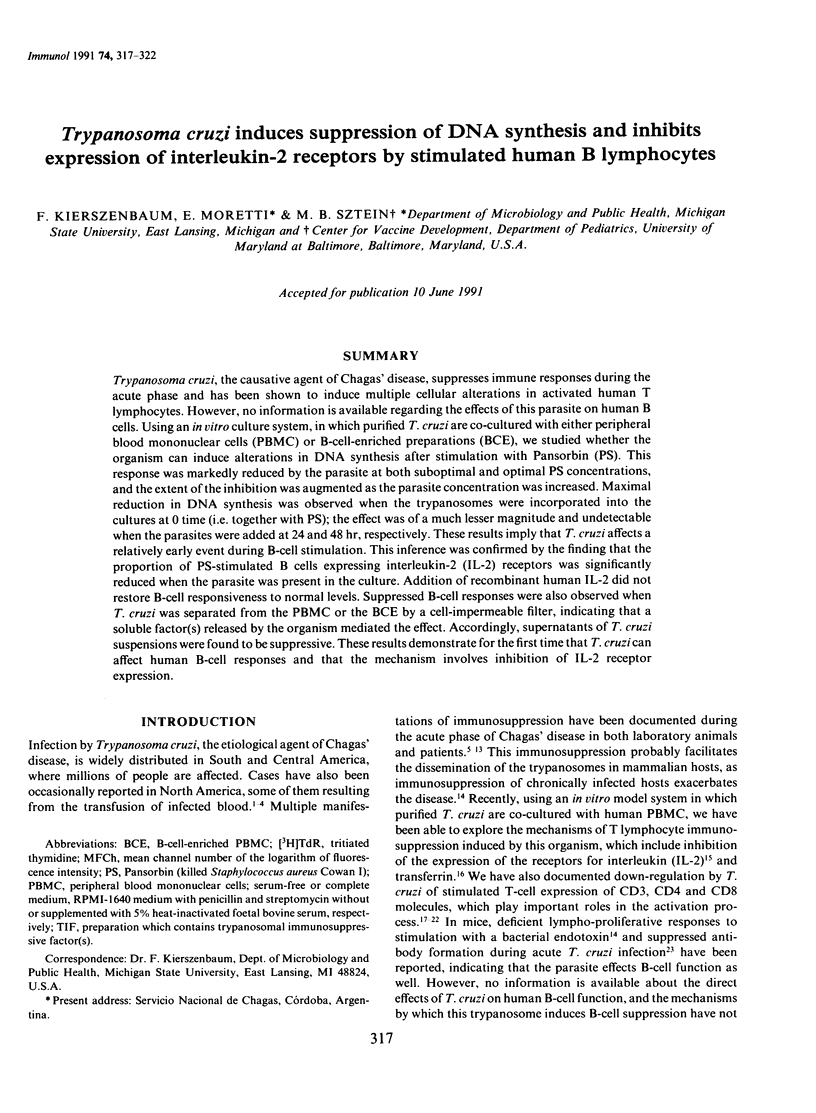
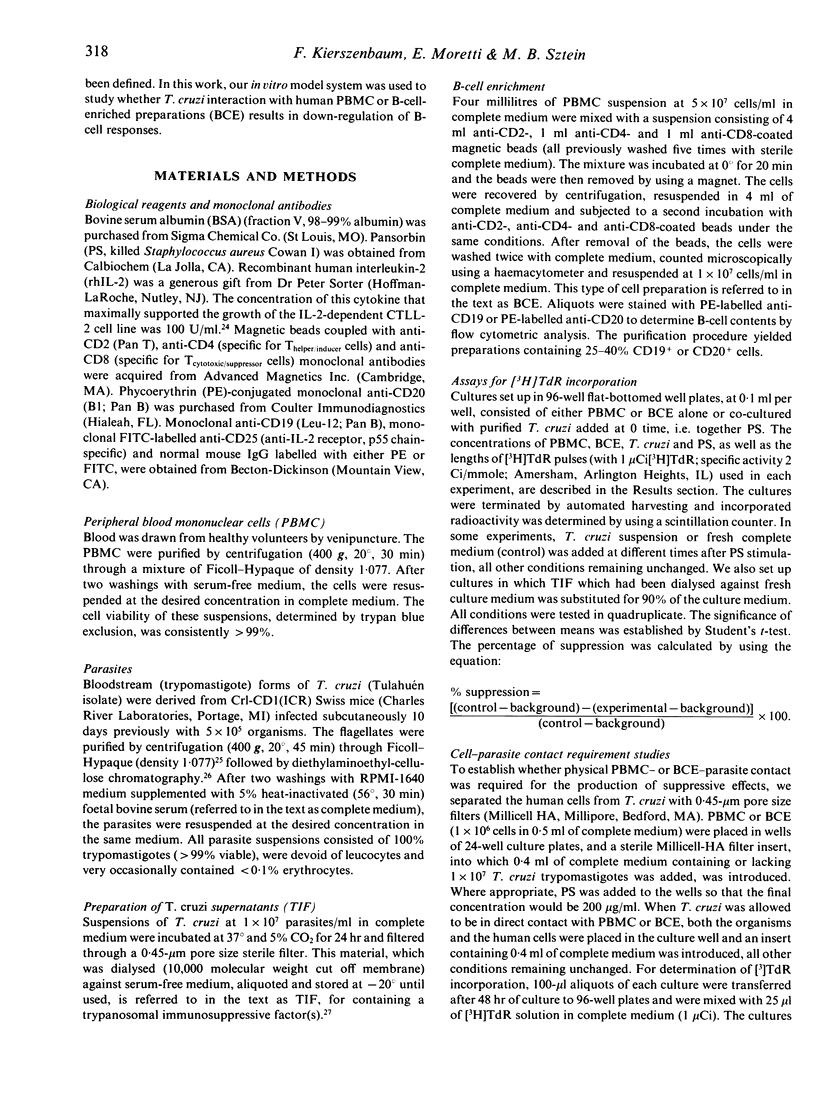
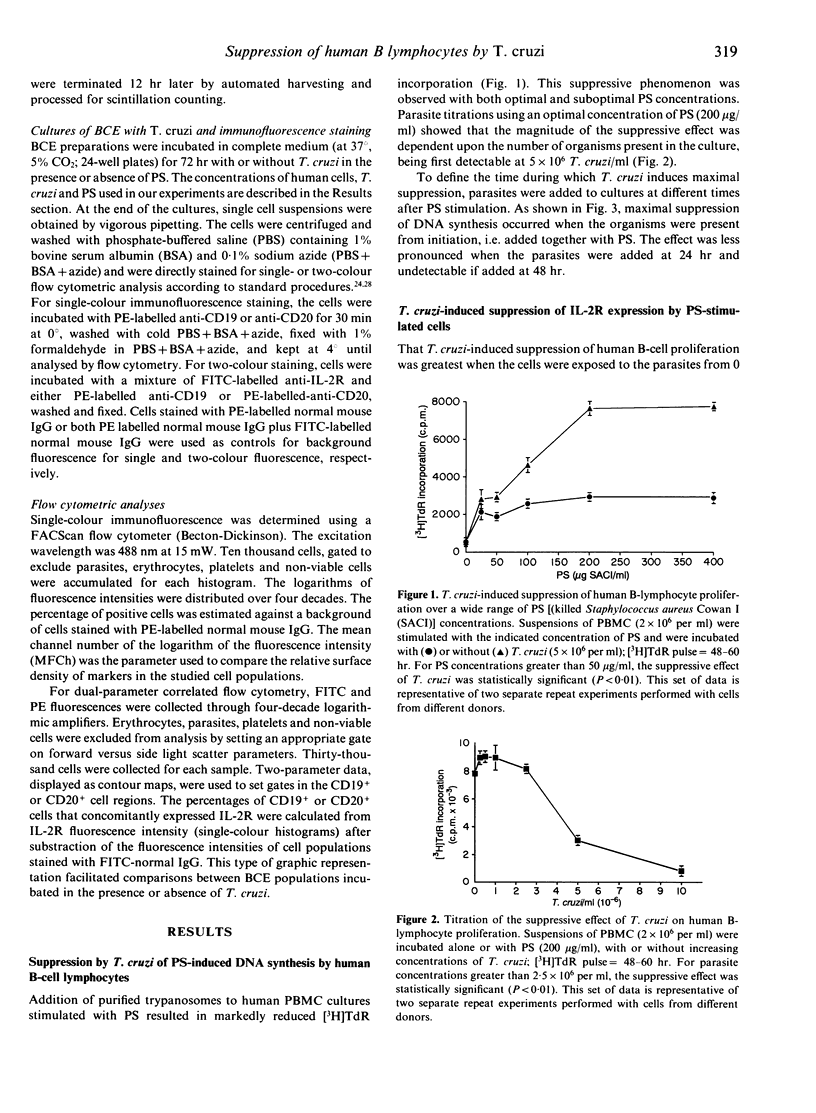
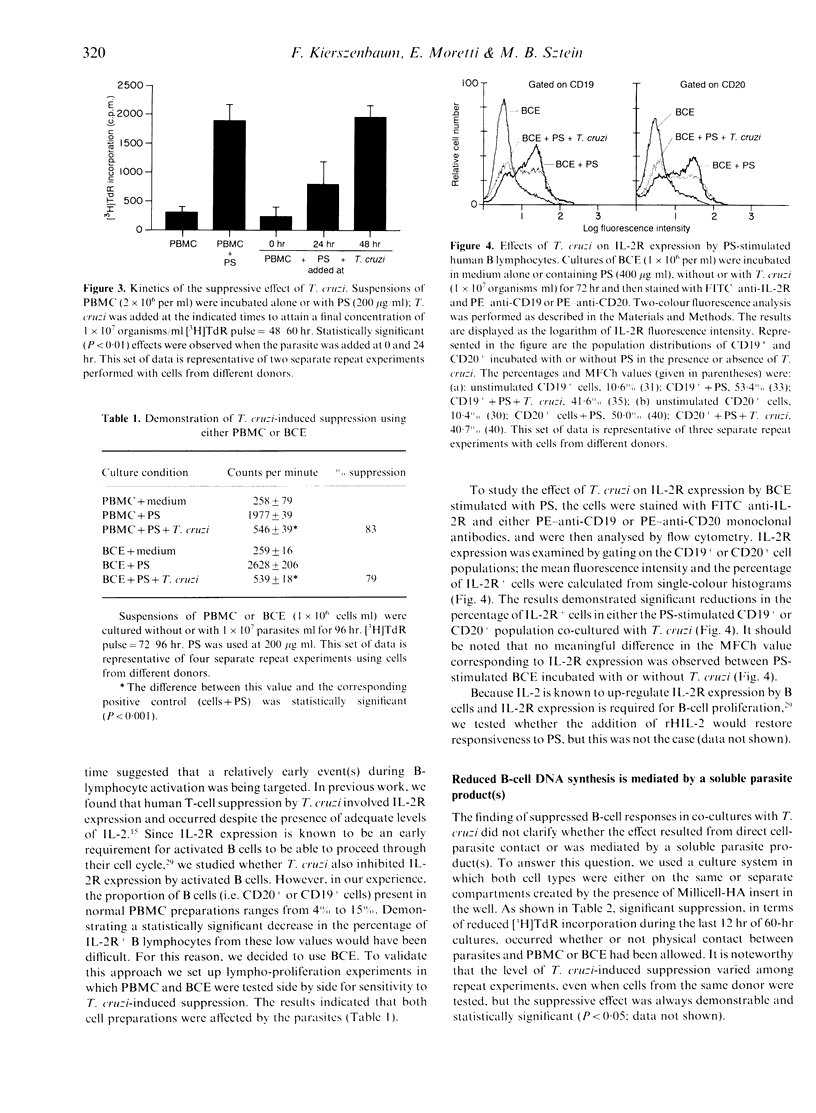
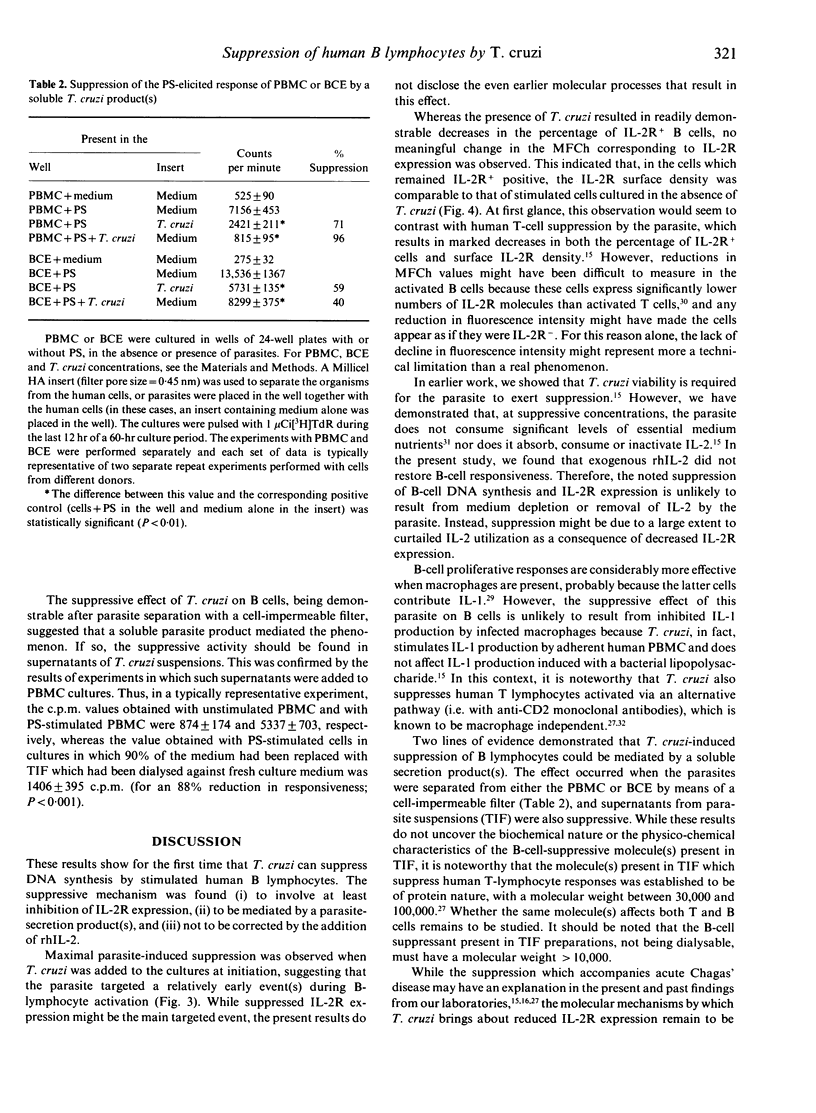
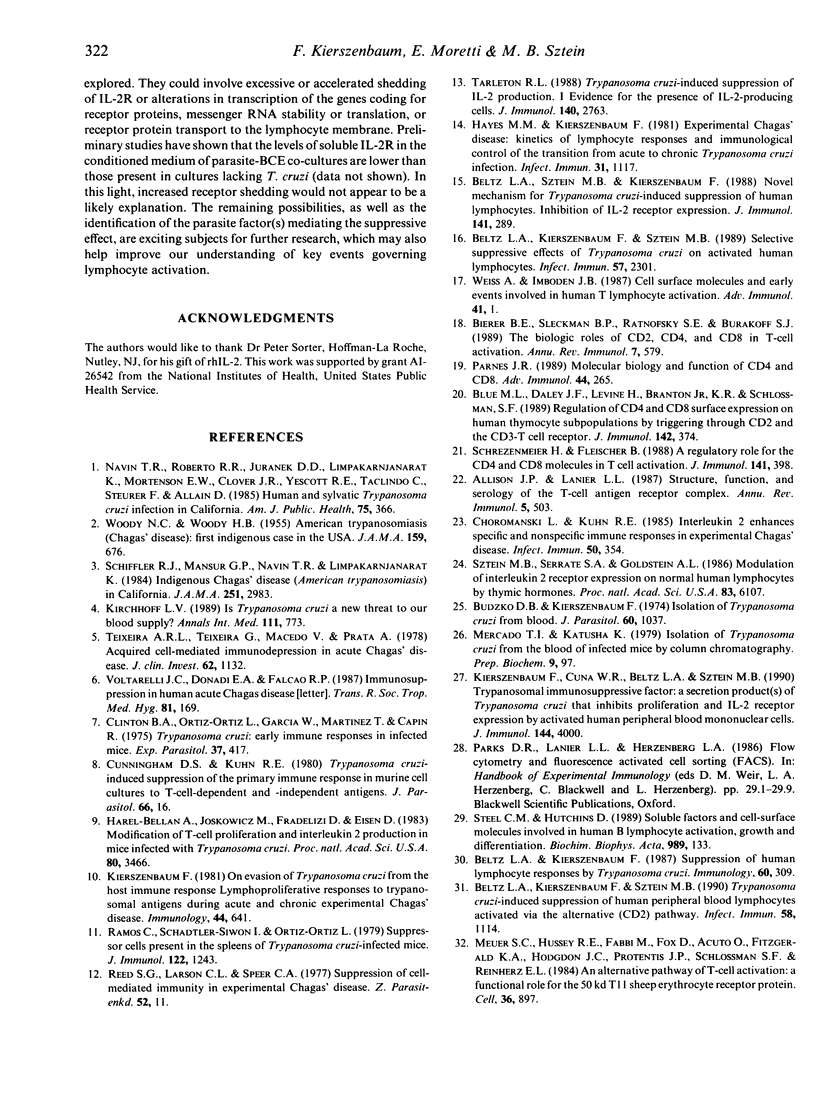
Selected References
These references are in PubMed. This may not be the complete list of references from this article.
- Allison J. P., Lanier L. L. Structure, function, and serology of the T-cell antigen receptor complex. Annu Rev Immunol. 1987;5:503–540. doi: 10.1146/annurev.iy.05.040187.002443. [DOI] [PubMed] [Google Scholar]
- Beltz L. A., Kierszenbaum F. Suppression of human lymphocyte responses by Trypanosoma cruzi. Immunology. 1987 Feb;60(2):309–315. [PMC free article] [PubMed] [Google Scholar]
- Beltz L. A., Kierszenbaum F., Sztein M. B. Selective suppressive effects of Trypanosoma cruzi on activated human lymphocytes. Infect Immun. 1989 Aug;57(8):2301–2305. doi: 10.1128/iai.57.8.2301-2305.1989. [DOI] [PMC free article] [PubMed] [Google Scholar]
- Beltz L. A., Kierszenbaum F., Sztein M. B. Trypanosoma cruzi-induced suppression of human peripheral blood lymphocytes activated via the alternative (CD2) pathway. Infect Immun. 1990 Apr;58(4):1114–1116. doi: 10.1128/iai.58.4.1114-1116.1990. [DOI] [PMC free article] [PubMed] [Google Scholar]
- Beltz L. A., Sztein M. B., Kierszenbaum F. Novel mechanism for Trypanosoma cruzi-induced suppression of human lymphocytes. Inhibition of IL-2 receptor expression. J Immunol. 1988 Jul 1;141(1):289–294. [PubMed] [Google Scholar]
- Bierer B. E., Sleckman B. P., Ratnofsky S. E., Burakoff S. J. The biologic roles of CD2, CD4, and CD8 in T-cell activation. Annu Rev Immunol. 1989;7:579–599. doi: 10.1146/annurev.iy.07.040189.003051. [DOI] [PubMed] [Google Scholar]
- Blue M. L., Daley J. F., Levine H., Branton K. R., Jr, Schlossman S. F. Regulation of CD4 and CD8 surface expression on human thymocyte subpopulations by triggering through CD2 and the CD3-T cell receptor. J Immunol. 1989 Jan 15;142(2):374–380. [PubMed] [Google Scholar]
- Budzko D. B., Kierszenbaum F. Isolation of Trypanosoma cruzi from blood. J Parasitol. 1974 Dec;60(6):1037–1038. [PubMed] [Google Scholar]
- Choromanski L., Kuhn R. E. Interleukin 2 enhances specific and nonspecific immune responses in experimental Chagas' disease. Infect Immun. 1985 Nov;50(2):354–357. doi: 10.1128/iai.50.2.354-357.1985. [DOI] [PMC free article] [PubMed] [Google Scholar]
- Clinton B. A., Ortiz-Ortiz L., Garcia W., Martinez T., Capin R. Trypanosoma cruzi: early immune responses in infected mice. Exp Parasitol. 1975 Jun;37(3):417–425. doi: 10.1016/0014-4894(75)90012-0. [DOI] [PubMed] [Google Scholar]
- Cunningham D. S., Kuhn R. E. Trypanosoma cruzi-induced suppression of the primary immune response in murine cell cultures to T-cell-dependent and -independent antigens. J Parasitol. 1980 Feb;66(1):16–27. [PubMed] [Google Scholar]
- Harel-Bellan A., Joskowicz M., Fradelizi D., Eisen H. Modification of T-cell proliferation and interleukin 2 production in mice infected with Trypanosoma cruzi. Proc Natl Acad Sci U S A. 1983 Jun;80(11):3466–3469. doi: 10.1073/pnas.80.11.3466. [DOI] [PMC free article] [PubMed] [Google Scholar]
- Hayes M. M., Kierszenbaum F. Experimental Chagas' disease: kinetics of lymphocyte responses and immunological control of the transition from acute to chronic Trypanosoma cruzi infection. Infect Immun. 1981 Mar;31(3):1117–1124. doi: 10.1128/iai.31.3.1117-1124.1981. [DOI] [PMC free article] [PubMed] [Google Scholar]
- Kierszenbaum F., Cuna W. R., Beltz L. A., Sztein M. B. Trypanosomal immunosuppressive factor: a secretion product(s) of Trypanosoma cruzi that inhibits proliferation and IL-2 receptor expression by activated human peripheral blood mononuclear cells. J Immunol. 1990 May 15;144(10):4000–4004. [PubMed] [Google Scholar]
- Kierszenbaum F. On evasion of Trypanosoma cruzi from the host immune response. Lymphoproliferative responses to trypanosomal antigens during acute and chronic experimental Chagas' disease. Immunology. 1981 Nov;44(3):641–648. [PMC free article] [PubMed] [Google Scholar]
- Kirchhoff L. V. Is Trypanosoma cruzi a new threat to our blood supply? Ann Intern Med. 1989 Nov 15;111(10):773–775. doi: 10.7326/0003-4819-111-10-773. [DOI] [PubMed] [Google Scholar]
- Mercado T. I., Katusha K. Isolation of Trypanosoma cruzi from the blood of infected mice by column chromatography. Prep Biochem. 1979;9(1):97–106. doi: 10.1080/00327487908061675. [DOI] [PubMed] [Google Scholar]
- Meuer S. C., Hussey R. E., Fabbi M., Fox D., Acuto O., Fitzgerald K. A., Hodgdon J. C., Protentis J. P., Schlossman S. F., Reinherz E. L. An alternative pathway of T-cell activation: a functional role for the 50 kd T11 sheep erythrocyte receptor protein. Cell. 1984 Apr;36(4):897–906. doi: 10.1016/0092-8674(84)90039-4. [DOI] [PubMed] [Google Scholar]
- Navin T. R., Roberto R. R., Juranek D. D., Limpakarnjanarat K., Mortenson E. W., Clover J. R., Yescott R. E., Taclindo C., Steurer F., Allain D. Human and sylvatic Trypanosoma cruzi infection in California. Am J Public Health. 1985 Apr;75(4):366–369. doi: 10.2105/ajph.75.4.366. [DOI] [PMC free article] [PubMed] [Google Scholar]
- Parnes J. R. Molecular biology and function of CD4 and CD8. Adv Immunol. 1989;44:265–311. doi: 10.1016/s0065-2776(08)60644-6. [DOI] [PubMed] [Google Scholar]
- Ramos C., Schädtler-Siwon I., Ortiz-Ortiz L. Suppressor cells present in the spleens of Trypanosoma cruzi-infected mice. J Immunol. 1979 Apr;122(4):1243–1247. [PubMed] [Google Scholar]
- Reed S. G., Larson C. L., Speer C. A. Suppression of cell-mediated immunity in experimental Chagas' disease. Z Parasitenkd. 1977 Jun 3;52(1):11–17. doi: 10.1007/BF00380553. [DOI] [PubMed] [Google Scholar]
- Schiffler R. J., Mansur G. P., Navin T. R., Limpakarnjanarat K. Indigenous Chagas' disease (American trypanosomiasis) in California. JAMA. 1984 Jun 8;251(22):2983–2984. [PubMed] [Google Scholar]
- Schrezenmeier H., Fleischer B. A regulatory role for the CD4 and CD8 molecules in T cell activation. J Immunol. 1988 Jul 15;141(2):398–403. [PubMed] [Google Scholar]
- Steel C. M., Hutchins D. Soluble factors and cell-surface molecules involved in human B lymphocyte activation, growth and differentiation. Biochim Biophys Acta. 1989 Dec 17;989(2):133–151. doi: 10.1016/0304-419x(89)90039-5. [DOI] [PubMed] [Google Scholar]
- Sztein M. B., Serrate S. A., Goldstein A. L. Modulation of interleukin 2 receptor expression on normal human lymphocytes by thymic hormones. Proc Natl Acad Sci U S A. 1986 Aug;83(16):6107–6111. doi: 10.1073/pnas.83.16.6107. [DOI] [PMC free article] [PubMed] [Google Scholar]
- Tarleton R. L. Trypanosoma cruzi-induced suppression of IL-2 production. I. Evidence for the presence of IL-2-producing cells. J Immunol. 1988 Apr 15;140(8):2763–2768. [PubMed] [Google Scholar]
- Teixeira A. R., Teixeira G., Macêdo V., Prata A. Acquired cell-mediated immunodepression in acute Chagas' disease. J Clin Invest. 1978 Dec;62(6):1132–1141. doi: 10.1172/JCI109232. [DOI] [PMC free article] [PubMed] [Google Scholar]
- Voltarelli J. C., Donadi E. A., Falcao R. P. Immunosuppression in human acute Chagas disease. Trans R Soc Trop Med Hyg. 1987;81(1):169–170. doi: 10.1016/0035-9203(87)90324-5. [DOI] [PubMed] [Google Scholar]
- WOODY N. C., WOODY H. B. American trypanosomiasis (Chagas' disease); first indigenous case in the United States. J Am Med Assoc. 1955 Oct 15;159(7):676–677. doi: 10.1001/jama.1955.02960240042010a. [DOI] [PubMed] [Google Scholar]
- Weiss A., Imboden J. B. Cell surface molecules and early events involved in human T lymphocyte activation. Adv Immunol. 1987;41:1–38. doi: 10.1016/s0065-2776(08)60029-2. [DOI] [PubMed] [Google Scholar]


